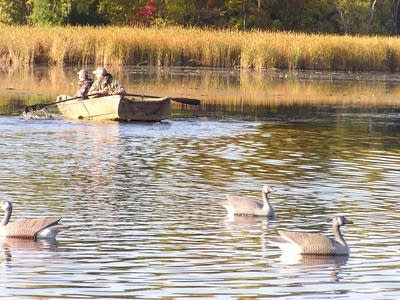Modern wildlife management began 150 years ago

It's just before sunrise and Bob Vidlund and Erik Kari are hunting ducks on a small lake in the northern Twin Cities suburbs.
As they drag their boat onto a bed of cattails for camouflage, they're not thinking about what happened 150 years ago that made this day possible. They bend cattails over the sides to hide the boat even more, from the ducks they hope will soon be flying in.
"It's amazing what a duck can see at 100 yards in the air," says Vidlund.
Misty, the Yellow Lab, is excited to see a beaver patrolling the dark water. Kari uses four separate calls to attract geese and ducks to within range of their guns.
Create a More Connected Minnesota
MPR News is your trusted resource for the news you need. With your support, MPR News brings accessible, courageous journalism and authentic conversation to everyone - free of paywalls and barriers. Your gift makes a difference.
The blackness gradually gives way to misty rose, and a light fog touches the lake.
Bob sees ducks coming in.

"To your left," he tells Erik.
Three shots ring out and the air fills with the smell of gunpowder.
"Got 'em. Fetch 'em out, Misty," orders Erik. "Nice shot, Bob."
It's Bob's first duck of the year.
"Got to like that," he says.
Misty brings in a wood duck.
"Isn't that a pretty duck," asks Bob. "Look at the colors on that."
They're happy with their luck today, but Bob Vidlund says there used to be a lot more ducks here.

"I think there's less and less wetland," he says. He and his hunting partners are members of the conservation group, Ducks Unlimited. "Less and less swamps, potholes. It's amazing how much the duck population has gone down over the years."
The population may have gone down, but if it weren't for that decision 150 years ago, there might not be any ducks at all. In 1858, the same year Minnesota joined the Union, the state set the first limits on hunting.
"This was literally the wild west," says Carrol Henderson, who runs the non-game wildlife division at the Minnesota DNR. The DNR has just published a book about the history of wildlife management in Minnesota, starting in territorial days.
"People used the wildlife as a survival resource. They used the deer, the moose, the prairie chickens, all these animals as a source of meat for their families."
And they trapped beavers, mink, pine marten, fisher, coyotes, and wolves, for their pelts.

"All of this was happening in era where there were no laws, no restrictions, no regulations. And wildlife was seen as simply a resource that was going to be used up, so you had to get there first, get your share, sell it, make some money off it or use it for survival, and there was no concern for the future."
And make money they did. Untold numbers of birds and animals were killed and packed up in pickle barrels and shipped east for consumption in restaurants and homes.
"Deer, moose, bear, prairie chickens, and ducks by the tens of thousands. And finally people realized that, 'We're killing all this stuff and shipping it off, and we're actually losing this resource, something we can enjoy for future because the numbers are just dramatically declining.' So I think there was a realization that the market hunting really put everything over the top."

Minnesota residents didn't like the state's early attempts to set limits on hunting. After the rules were established closed seasons to protect breeding, limits were then added and finally there were restrictions on methods of hunting. But commercial hunting for east coast markets didn't end until 1893.
According to Carrol Henderson, many Minnesotans kept taking as much as they could for their own use, until well into the 1920s and 1930s.
Today, the rules that Bob Vidlund and Erik Kari follow are the direct descendants of those first game laws, passed back in 1858. The rules are a lot more complicated now. These two hunters can only start shooting a half-hour before sunrise, they can take only six ducks each. Other rules govern which species can be killed and which cannot.
Today they take home four ducks.


